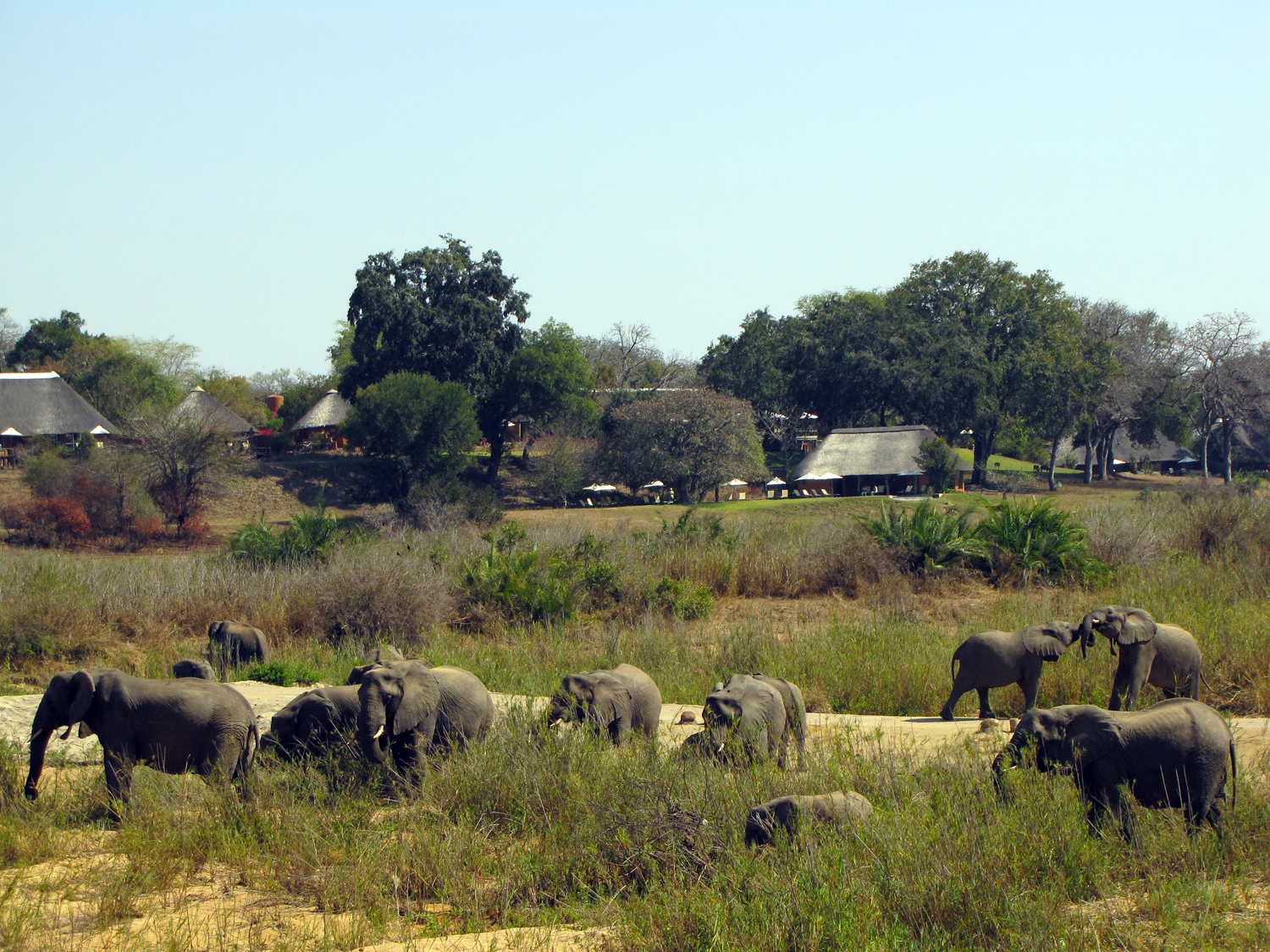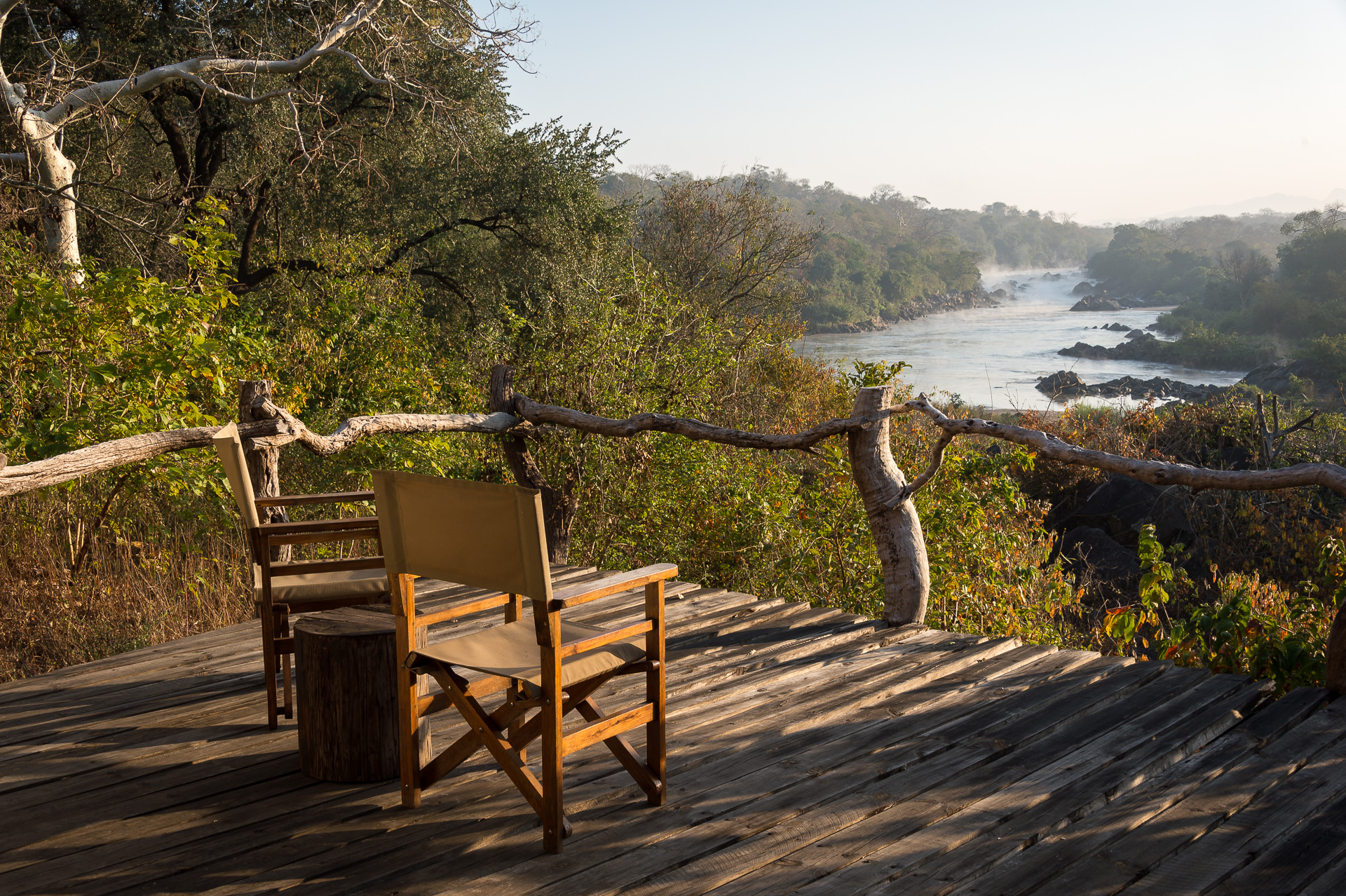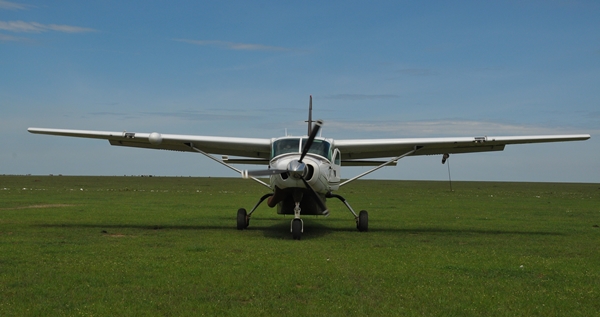The Greater Kruger is an unfenced wilderness in South Africa , stretching over 400km from north to south. It combines private reserves and the national park and is known for high densities of lion, leopard and elephant. There are many ways to explore this wonderful and very accessible region which is at its peak between May and October during the long cool winter months.
A safari in Kruger lends itself perfectly to being incorporated into a longer holiday in Southern Africa, whether that’s heading north to Victoria Falls on the border between Zimbabwe and Zambia, relaxing in the Cape Winelands or combining Southern Africa’s highlights with a luxury Rovos Rail journey.
Here, we review our recent stay at MalaMala as well as giving general information about the Kruger and how to combine it in your holiday.
Location
Three distinct camps (Main Camp, Sable Camp, Rattray’s Camp) stretch out along the Sand River in the vast MalaMala Private Game Reserve. The reserve is sandwiched between the famous Sabi Sands region of Greater Kruger and Kruger National Park itself -it is the largest private Big Five game reserve in South Africa, comprising 13 300 ha (33 000 acres). The borders are unfenced allowing wildlife to migrate unhindered. The size of the reserve ensures guests enjoy an exclusive safari experience – you’ll see other MalaMala vehicles and anti-poaching teams going about their work but very little other traffic.
This area is known to be one of the best in Africa for seeing leopard. Guests have a good chance of seeing the MalaMala Big Seven (Lion, Leopard, Cheetah, Elephant, Buffalo, Rhino, Wild Dog).
The setting is very beautiful with the Sand River in front of camp. The reserve has lots of contrasting scenery with dramatic granite kopjes (punctuated with klipspringer), mud holes perfect for white rhino and buffalo wallowing, the river for crocodile, hippo and elephant, open plains, forest, huge sausage trees and statuesque euphorbia candelabrum.
Access
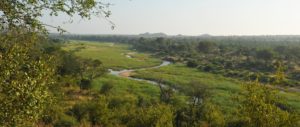 The camp can be accessed via fly-in from Johannesburg (and Cape Town), either fly and transfer via Skukuza (about an hour’s drive away) or Nelspruit KMIA (2 hour road transfer) or a private charter to the airstrip moments from camp.
The camp can be accessed via fly-in from Johannesburg (and Cape Town), either fly and transfer via Skukuza (about an hour’s drive away) or Nelspruit KMIA (2 hour road transfer) or a private charter to the airstrip moments from camp.
We hired an SUV in Johannesburg and stopped off in Hazyview for a night (staying at Rissington Inn – an easy 4 hour drive mostly on the N12, from OR Tambo) which then made MalaMala a simple 2 hour drive the following morning. The first hour or so is on tarred road, we then registered at Shaws Gate, paying our park fees, to enter the reserve area. There is an undulating dirt track which is well sign -posted with plenty of passing places. We came across this beautiful male leopard within moments of starting our 20km journey to MalaMala. We also saw elephant and white rhino along with many antelope and zebra.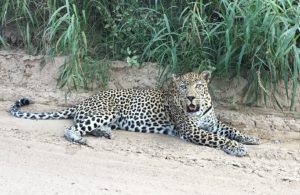
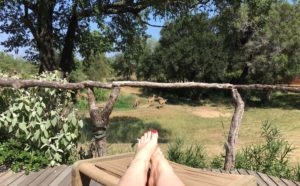 Accommodation and style
Accommodation and style
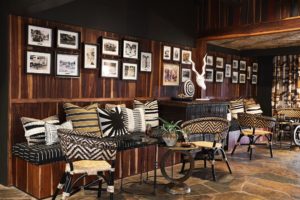
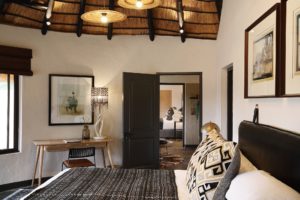 We stayed at Main Camp, the largest of the three camps, which consists of 19 luxury air-conditioned thatched rooms and suites. The lodge has been on this spot since the 1930s, originally a hunting lodge and converting to conservation and photography in the 60s – the first to do so. The camp was completely refurbished in 2018 and transformed from the old-school and old-fashioned hunting lodge style, to a beautiful far more contemporary property – the refurb has been sensitive with the historic exterior, boma, where Nelson Mandela has dined and various artworks all preserved.
We stayed at Main Camp, the largest of the three camps, which consists of 19 luxury air-conditioned thatched rooms and suites. The lodge has been on this spot since the 1930s, originally a hunting lodge and converting to conservation and photography in the 60s – the first to do so. The camp was completely refurbished in 2018 and transformed from the old-school and old-fashioned hunting lodge style, to a beautiful far more contemporary property – the refurb has been sensitive with the historic exterior, boma, where Nelson Mandela has dined and various artworks all preserved.
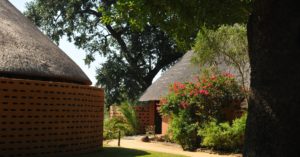 Travelling as a family we stayed in one of the Waterhole Suites. Other rooms/suites face the other direction towards the Sand River. The children had their own twin room and bathroom which led to a huge double bedroom, bathroom with bath and shower and wonderful outdoor shower.
Travelling as a family we stayed in one of the Waterhole Suites. Other rooms/suites face the other direction towards the Sand River. The children had their own twin room and bathroom which led to a huge double bedroom, bathroom with bath and shower and wonderful outdoor shower.
Along the front of the room and accessed from both bedrooms by sliding glass doors was a wooden deck looking over the waterhole where we had hippo, nyala, kudu and mongoose as visitors. Rooms are extremely comfortable and stylish, retaining an African flavour with a natural colour palate, porqupine quill lamp and wildlife artworks. There are many thoughtful touches, for instance umbrellas in the hall, USB ports, extensive mini bar and fresh ice, a sweetie jar for the children. Closets had lighting, towels were fluffy and complimentary bath products smelt divine.
Sable and Rattray’s camp are smaller and quieter. No children under 12 are permitted at Sable Camp and no children under 16 at Rattray’s Camp.
Seasonality
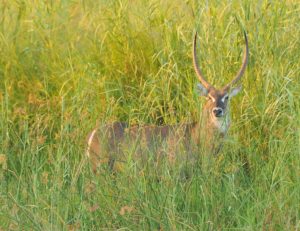 MalaMala is open year-round. Visiting in April we knew it was the end of the rainy season and the bush would be very lush. As expected the weather was rather unpredictable. One day we had blue skies and temperatures of 38 degrees and the next it was 22 degrees cloudy and raining – we quite enjoyed the contrast – we still saw amazing wildlife, the landscape was beautiful, and even when we got soaked on the morning drive we knew we were returning to lovely hot showers, coffee and breakfast!
MalaMala is open year-round. Visiting in April we knew it was the end of the rainy season and the bush would be very lush. As expected the weather was rather unpredictable. One day we had blue skies and temperatures of 38 degrees and the next it was 22 degrees cloudy and raining – we quite enjoyed the contrast – we still saw amazing wildlife, the landscape was beautiful, and even when we got soaked on the morning drive we knew we were returning to lovely hot showers, coffee and breakfast!
May to October (the cool dry winter) is considered the peak time for this area – the bush starts to dry out and die back, and weather is more consistent and reliable. Wildlife is easier to see as it gathers around the water sources and is not so easily concealed by the bush. If you are keen to combine a safari in Greater Kruger with a stay in Cape Town then April/May and September/October are the best months.
The safari day
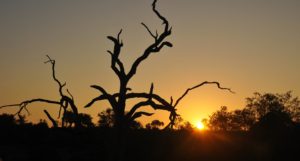 The daily schedule changes with the seasons – for our stay we would be woken at 515am, for tea/coffee and a light snack on the deck at 545am with other guests, before departing at 6am. We would usually be back at camp for a hearty breakfast by about 9am.
The daily schedule changes with the seasons – for our stay we would be woken at 515am, for tea/coffee and a light snack on the deck at 545am with other guests, before departing at 6am. We would usually be back at camp for a hearty breakfast by about 9am.
After breakfast there is time to relax and enjoy the camp – for instance the swimming pool with its glorious views over the Sand River. It’s lovely to sit and read, or watch the wildlife come and go from the waterhole. We’d have lunch about 1pm – lunch is delicious!! Depending how much you indulge you may need a lie down afterwards…
Breakfast and lunch are both in a buffet format and very high quality with a good choice. Where possible we dined alfresco on the deck. Breakfast included fresh fruit, juice, a hot buffet including pancakes or waffles and fresh breads. Lunch always included a lovely selection of salads plus cold meats, quiche and condiments as well as a hot option, for example, a curry. There was a choice of desert from fruit salad and ice-cream to lemon meringue.
In the afternoon we would meet at 3-315pm (more bite size treats on offer plus tea/coffee and cold drinks) and leave at 345pm, returning to camp at around 7pm. On one evening we did stop for sundowners out on the reserve but wildlife viewing certainly takes priority here. Pre dinner drinks and nibbles would be in the bar at around 745pm with dinner following. We enjoyed gathering in the bar and completing the ‘sightings board’ each evening with all the guests and rangers – a very communal activity.
Dinner is chosen from a set menu with Michael the barman suggesting suitable wine pairings from the delicious range of South African wines. We enjoyed a candle-lit dinner on the deck on our first evening and joined fellow guests around the camp fire in the ancient boma, beneath the jackalberry tree on the following evening. Members of staff presented a cake and sang traditional songs around the fire to help one couple celebrate their Golden Wedding Anniversary.
Staff
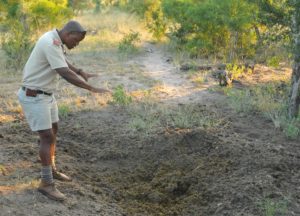 The staff added greatly to our experience from the efficient management team of Nerine, Alex and Vusi to the waiting staff such as smiling Stephalina with 22 years service. Everyone gets to know Michael-the-barman, who is a joy. Our guide was Thabisani from Richard’s Bay – he was a lovely chap, a skilful driver and very knowledgeable – we even learnt some Zulu and Shangaan in two days. We enjoyed talking to him about all manner of things from culture to wildlife. It is customary for rangers to join guests for breakfast and sometimes at other meals as well.
The staff added greatly to our experience from the efficient management team of Nerine, Alex and Vusi to the waiting staff such as smiling Stephalina with 22 years service. Everyone gets to know Michael-the-barman, who is a joy. Our guide was Thabisani from Richard’s Bay – he was a lovely chap, a skilful driver and very knowledgeable – we even learnt some Zulu and Shangaan in two days. We enjoyed talking to him about all manner of things from culture to wildlife. It is customary for rangers to join guests for breakfast and sometimes at other meals as well.
The folder in the room dodges the question of tipping and leaves it very much at the discretion of guests which we can understand as it is a tricky one. For many people, a safari holiday is the most expensive trip they will ever make but if you can tip then it is hugely appreciated by the staff. As a very general budget we usually work on $10-$30 US per person per day. You tip your guide/ranger directly with the ‘golden handshake’ at the end of the stay, and place your contribution for behind the scenes staff into the tip box (usually at reception).
Vehicles
The vehicles are completely open allowing for unrivalled wildlife viewing. They have 3 rows of 2 seats meaning everyone had a great view. They are very comfortable and the camp has steps to help those with reduced mobility get in and out more easily. There is a central hatch between each pair of seats for putting your camera or binos. In here you’ll also find blankets and ponchos. There is also a place to put your water bottle (each guest is presented with a smart named metal water bottle on arrival and can refill this with still or sparkling water from the main deck water station as needed).
Wildlife
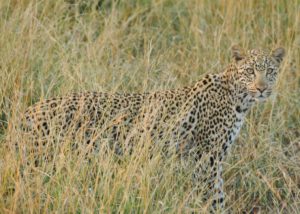
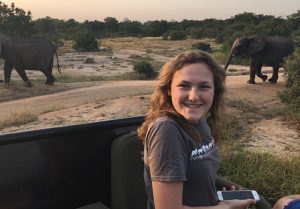 Sabi Sands is known to be one of the best places to see leopard in Africa but we really did not expect to come across one within 5 minutes of driving through Shaw’s Gate! This was one of three leopard sightings during our short 2 night stay. We also had the joy of observing a pack of 8 Cape Hunting Dogs (wild dogs) as they socialised and warmed up on the tarred airstrip as the sun came up. I was not expecting to see cheetah with the bush so dense but we were treated to a fascinating face off on the last morning between an injured male and a hyena.
Sabi Sands is known to be one of the best places to see leopard in Africa but we really did not expect to come across one within 5 minutes of driving through Shaw’s Gate! This was one of three leopard sightings during our short 2 night stay. We also had the joy of observing a pack of 8 Cape Hunting Dogs (wild dogs) as they socialised and warmed up on the tarred airstrip as the sun came up. I was not expecting to see cheetah with the bush so dense but we were treated to a fascinating face off on the last morning between an injured male and a hyena.
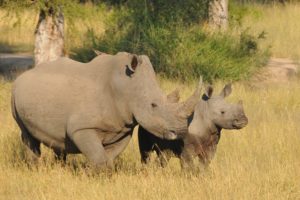 We enjoyed numerous and incredibly rewarding white rhino sightings, seeing several young with their mothers and being able to watch really interesting behaviour.
We enjoyed numerous and incredibly rewarding white rhino sightings, seeing several young with their mothers and being able to watch really interesting behaviour.
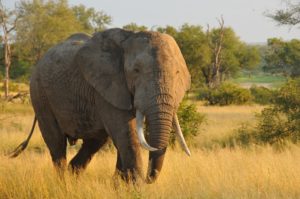 We saw elephant on the way to MalaMala and caught up with a lovely big bull on one of the afternoon drives but we had to work hard to see any others which is unusual for this area.
We saw elephant on the way to MalaMala and caught up with a lovely big bull on one of the afternoon drives but we had to work hard to see any others which is unusual for this area. 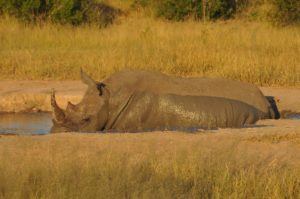 We were rewarded for our patience in the end with one the most memorable elephant sightings I’ve ever had – a huge herd on the move surrounded our vehicle just before sundown – there must have been at least 80 elephants with lots of babies. It was incredibly special – you can see the short video clip on our social media feeds (Facebook; Instagram; Twitter).
We were rewarded for our patience in the end with one the most memorable elephant sightings I’ve ever had – a huge herd on the move surrounded our vehicle just before sundown – there must have been at least 80 elephants with lots of babies. It was incredibly special – you can see the short video clip on our social media feeds (Facebook; Instagram; Twitter).
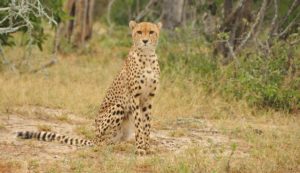 Lion were equally elusive – one large pride had been feeding on a rhino carcass for a couple of days (died from natural causes) on the neighbouring conservancy of Londolozi and continued to feast there during our stay, not appearing until we left! (We managed to see fabulous lion feeding on a buffalo kill further south in Kruger National Park.)
Lion were equally elusive – one large pride had been feeding on a rhino carcass for a couple of days (died from natural causes) on the neighbouring conservancy of Londolozi and continued to feast there during our stay, not appearing until we left! (We managed to see fabulous lion feeding on a buffalo kill further south in Kruger National Park.)
Antelope, zebra, giraffe, buffalo, hippo and many different bird species were all easy to see. We even saw a crocodile in the river. The most unusual sighting had to be the honey badger as it raced across the track right in front of us.
Value for money
Make no mistake, MalaMala is at the top end of the safari spectrum. Rates included all meals, drinks, game activities and WiFi. Hospitality, food and drink, guiding and accommodation were all exceptional, generous and wildlife sightings were rich and varied.
South Africa is an excellent holiday choice currently – the South African Rand is about 18 to the Pound (April 2019) so you can enjoy a diverse holiday combining a few days on safari with time on the Cape coast for example, for really good value, in comparison to other destinations.
Staying in a private reserve permits off-roading and the chance to have very close wildlife encounters. You can also drive at night. If you are on safari in the national park you are limited to using the set road routes and you can only drive between sunrise and sunset. They each offer very different experiences.
We offer many different camps and lodges in the Greater Kruger covering a range of price points, from small tented camps such as Garonga and Honeyguide to luxury lodges including MalaMala, Arathusa and Motswari. Please speak to us for advice.
 Wild weekend – how we like to incorporate a safari to Greater Kruger within a holiday
Wild weekend – how we like to incorporate a safari to Greater Kruger within a holiday
How long to safari? 2 nights is really too short – we prefer a minimum stay of 3 nights in any one camp so you can really have a chance to see as much as possible (Kruger is a vast area so it also works well combining stays in different locations as we did).
Whether you fly-in or drive-in there are many ways to combine safari time in Greater Kruger within a longer holiday. Here are a few ideas:
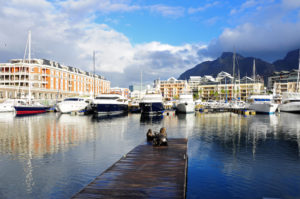 Stay in the Cape – fly from Johannesburg or KMIA Nelspruit to/from Cape Town. Kruger and the Cape are best combined April/May or September/October.
Stay in the Cape – fly from Johannesburg or KMIA Nelspruit to/from Cape Town. Kruger and the Cape are best combined April/May or September/October.
Visit Victoria Falls – you can fly on to Victoria Falls from Johannesburg or to Livingstone (the Zambian side of the Falls) from KMIA Nelspruit making for a fabulous cross border holiday.
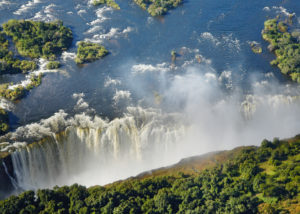
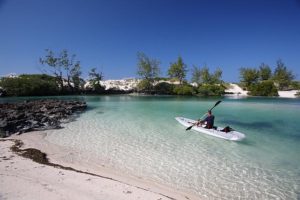 Escape to the beaches of Mozambique or Mauritius – there are many options here – you can travel by road from Southern Kruger across the border to Maputo in about 3 hours, for beaches in Southern Mozambique, or you can fly to Vilanculos for the Quirimbas. Alternatively you can overnight at Johannesburg airport and fly to the island of Mauritius.
Escape to the beaches of Mozambique or Mauritius – there are many options here – you can travel by road from Southern Kruger across the border to Maputo in about 3 hours, for beaches in Southern Mozambique, or you can fly to Vilanculos for the Quirimbas. Alternatively you can overnight at Johannesburg airport and fly to the island of Mauritius.
Go golfing – wish list golf courses are within reach of Kruger including Leopard Creek on the southern edge. Sun City is also easily combined with a safari to Kruger.
Take the train – two of the world’s most luxurious trains operate in southern Africa out of Pretoria including the Blue Train and Rovos Rail. The Blue Train has a special Kruger itinerary as well as a 2 night journey to Cape Town. Rovos operates to Cape Town as well as a special golf and safari itinerary.
Explore by car – self-drive the stunning Panorama route in Mpumalanga or connect south to Durban to explore the battlefields of KwaZulu Natal. The Drakensberg Mountains are another option.
Looking for a malaria free safari option? South Africa has several malaria free Big Five reserves – speak to us about Madikwe or the Eastern Cape.
To find out more about holidays to South Africa please visit the dedicated country page on the Real Africa website or call us for a chat on 01603 964 730.
